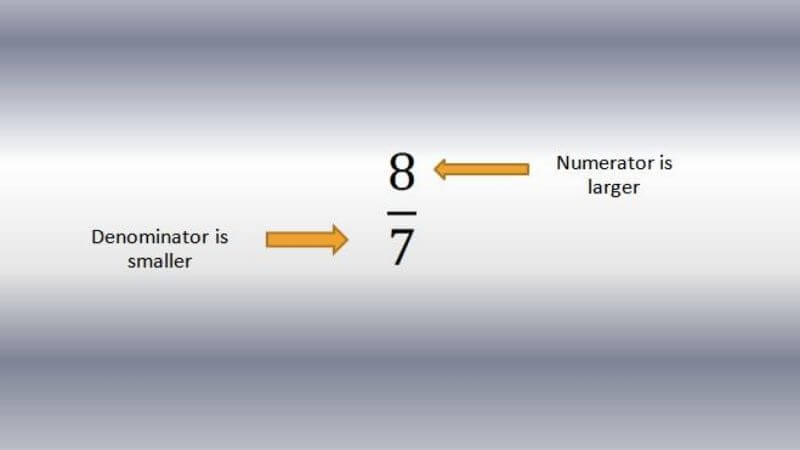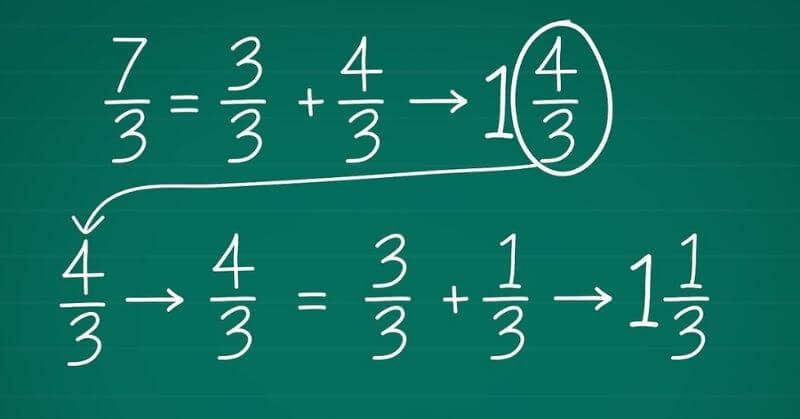Before going to an improper fraction, you must know what fractions are. In mathematics, there are various types of numbers, one of them is fractions. It can be defined as the type of fraction where the numerator is greater than the denominator or equal to the denominator. Some examples of improper fractions are as follows: 10/4, 6/4, 5/2, 3/2, and so on. These types of fractions are easier to solve rather than the other type of fractions. A mixed fraction is also one of the examples of a fraction where the number is formed by combining both the whole number and the part of the fraction. Some examples of Mixed fractions are as follows: 3 * 1 / 7 or 8 * 1 / 2. A mixed fraction is comparatively easier to interpret and understand if we compare it with the improper fraction. In this article, we may cover some basic concepts regarding the fractions such as: what are fractions, conversion of improper fraction into a decimal and mixed fraction and do a detailed analysis about those topics.
What Are Fractions?
Any value which can be expressed or represented as the portion of a whole can be defined as a fraction or fraction number. This term ‘fraction’ was derived from the words of Latin which means ‘to break’. Fractions originally came to use as early as the Egyptian Civilization. It was used to solve various mathematical problems which included food supply, exchange of coins, and many more. The use of fractions was varying in different parts of the world. For example, In India, the fraction was written as numerator/denominator. In Rome, it was written as a portion of the whole number. The portion which has been represented can be defined as the numerator. It is written above the denominator. The total parts in which the whole has been divided or classified is known as the denominator. It is written below the numerator. A fraction has been divided into six different types. We shall cover those types in the next few sections.
Types Of Fractions

As mentioned above, any value which can be expressed or represented as the portion of a whole can be defined as a fraction. Fractions are classified into six types. The following are the types of fractions:
- A fraction where the numerator is smaller as compared to the denominator is known as a proper fraction. For example, 5/7, ⅖, 3,6, and so on.
- The type of fraction where the numerator is greater than the denominator or equal to the denominator. Some examples of improper fractions are as follows: 10/4, 6/4, 5/2, 3/2, etc.
- A fraction where the value of the numerator is written as ‘1’ is known as a unit fraction. For example, ⅕, ⅛, etc.
- A fraction where the number is formed by combining both the whole number and the part of the fraction. Some examples of Mixed fractions are as follows: 3 * 1 / 7 or 8 * 1 / 2.
- Fractions that represent the exact value as the portion of a whole are defined as equivalent fractions.
- The fractions of the same denominators are known as Like fractions. Two fractions of different denominators are known as, Unlike fractions.
Conversion Of Improper Fraction Into Decimals
The conversion of improper fractions into decimals can be easily accomplished by simply dividing the numerator with the denominator. Let us take some examples so that the concept becomes clearer to you. Some of them are mentioned below:
Example 1: Convert 10/4 which is an improper fraction into a decimal?
Solution: Given that,
Improper Fraction = 10/4
Dividing the numerator by denominator = 2.5
Thus, 10/4 = 2.5.
Visit Cuemath, if you want to study these concepts in a detailed, fun, and interactive manner.
Follow Us: Facebook | Instagram | Twitter |
Entertales is on YouTube; click here to subscribe for the latest videos and updates.














